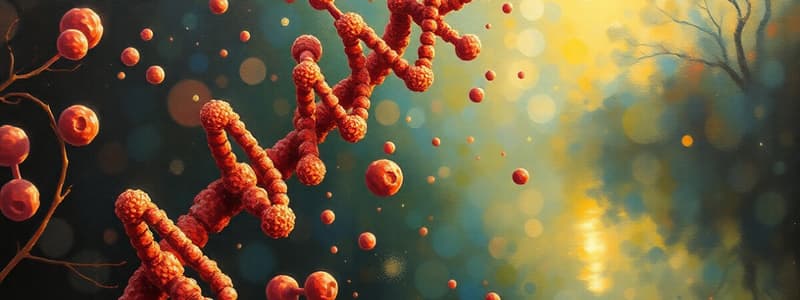Podcast
Questions and Answers
What characteristic is typically associated with carbohydrates that have a low affinity to water?
What characteristic is typically associated with carbohydrates that have a low affinity to water?
- They are hydrophilic.
- They do not dissolve in water. (correct)
- They are soluble in water.
- They form gels in aqueous solutions.
Which type of molecule is DNA?
Which type of molecule is DNA?
- A nucleic acid. (correct)
- A carbohydrate.
- A lipid.
- A protein.
Which of the following statements is true regarding RNA?
Which of the following statements is true regarding RNA?
- RNA contains thymine as a base.
- RNA is a type of carbohydrate.
- RNA is double-stranded.
- RNA is involved in protein synthesis. (correct)
What is a key difference between DNA and RNA?
What is a key difference between DNA and RNA?
What type of biomolecule does NOT include carbohydrates among its classifications?
What type of biomolecule does NOT include carbohydrates among its classifications?
Flashcards are hidden until you start studying
Study Notes
Carbohydrate Properties
- Hydrophobicity: Carbohydrates with a low affinity for water are often characterized by a non-polar structure. This lack of polarity results in their low water solubility and tendency to repel water molecules.
DNA Structure
- Nucleic Acid: DNA (deoxyribonucleic acid) is classified as a nucleic acid molecule, responsible for storing and transmitting genetic information.
RNA Structure
- Single-stranded: Unlike DNA, RNA (ribonucleic acid) is a single-stranded molecule, allowing it to fold into complex three-dimensional structures which contribute to its diverse functions in protein synthesis and cellular regulation.
DNA vs RNA
- Sugar Structure: A key difference between DNA and RNA lies in the sugar molecules that form their backbone. DNA contains deoxyribose while RNA contains ribose, a sugar with an extra hydroxyl group.
Biomolecule Classifications
- Lipids: Lipids, a diverse group of biomolecules, do not include carbohydrates as part of their classification. They are characterized by their hydrophobic nature and serve crucial roles in energy storage, cell membrane structure, and signaling.
Studying That Suits You
Use AI to generate personalized quizzes and flashcards to suit your learning preferences.




